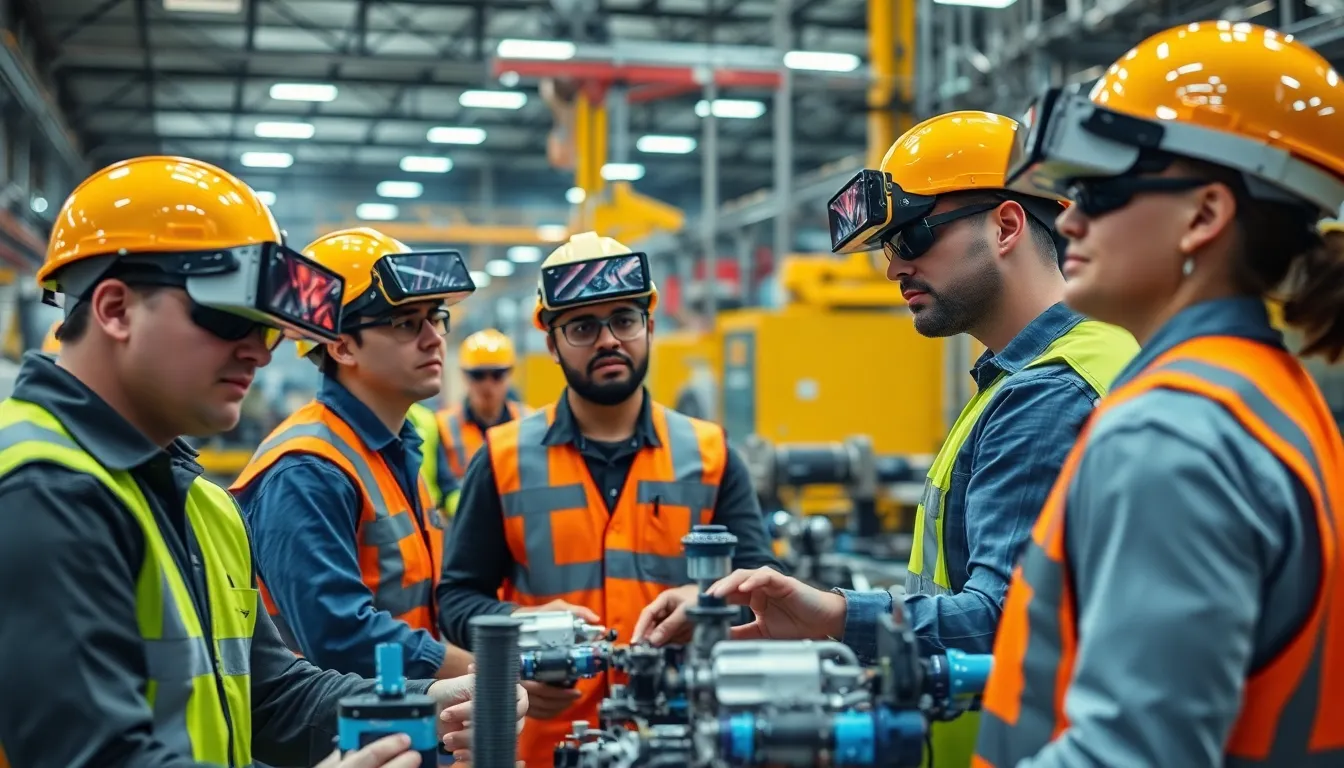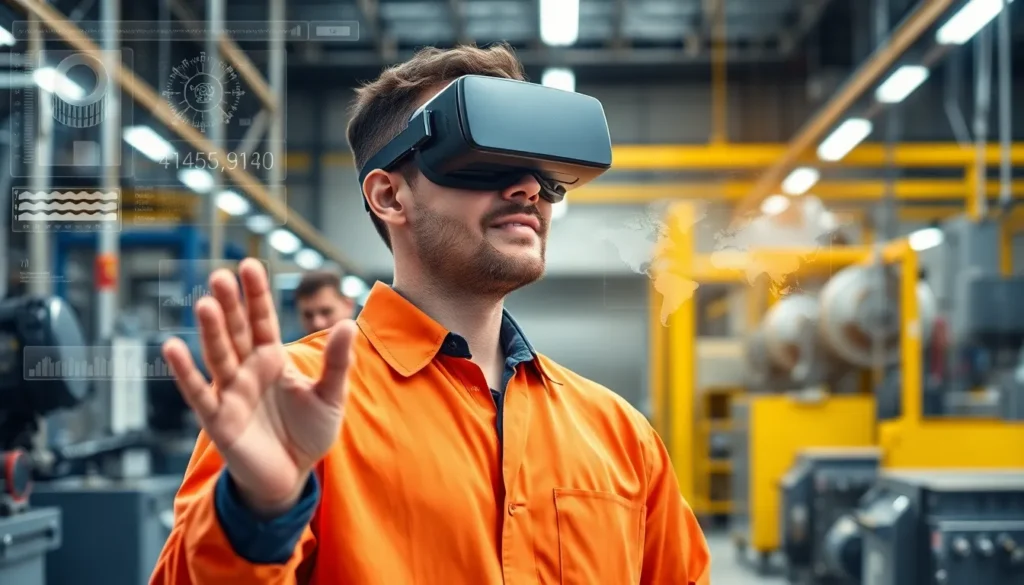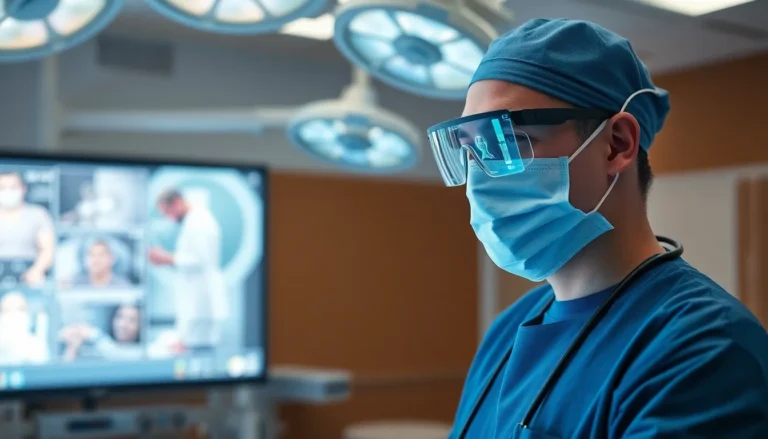Table of Contents
ToggleImagine walking onto a factory floor where your machines can talk back, and your workers sport virtual goggles instead of hard hats. Augmented Reality (AR) is shaking up the manufacturing world, turning mundane tasks into interactive experiences. It’s like giving your production line a high-tech makeover, where efficiency meets innovation in a dazzling dance of pixels and reality.
As manufacturers face increasing demands for speed and precision, AR swoops in like a superhero, offering real-time data and immersive training. It’s not just about making things look cool; it’s about boosting productivity and reducing costly errors. So, get ready to explore how AR is revolutionizing the way factories operate, making them smarter, faster, and a whole lot more fun.
Overview of AR in Manufacturing
Augmented Reality (AR) significantly enhances various facets of manufacturing. It streamlines processes by overlaying digital information onto the physical environment. Workers visualize complex data in real time, which fosters precise decision-making.
Training programs utilizing AR enable employees to learn in immersive environments. This method reduces the time required for training while boosting retention rates. Companies note fewer errors and improved performance after implementing AR solutions.
Maintenance and assembly tasks benefit from AR’s real-time guidance features. Instructions displayed through AR devices increase accuracy and efficiency. Technicians complete repairs more swiftly, minimizing downtime and enhancing productivity.
Additionally, AR supports remote assistance capabilities. Experts can guide on-site workers through complex tasks from any location, reducing travel costs. These interactions leverage visual aids that lead to faster troubleshooting.
Manufacturers recognize AR’s role in increasing competitive advantage. It enhances product design validation through simulations and digital prototypes. Engaging with AR solutions equips companies to adapt to market shifts more effectively.
Industrial sector growth includes AR’s application in quality control as well. Automated inspections powered by AR technologies streamline processes and maintain product standards. Inspectors also rely on digital overlays that highlight defects, ensuring higher quality products.
AR transforms the manufacturing landscape through these applications. Adoption continues to rise, and organizations increasingly harness its potential for optimizing operations. Flexibility in production processes becomes vital for staying ahead in a fast-paced industry.
Benefits of AR in Manufacturing

AR technology significantly impacts the manufacturing industry, enhancing various aspects of operations and processes.
Enhanced Visualization
AR provides workers with the ability to see complex data and processes superimposed on their physical surroundings. Visual aids such as 3D models assist in understanding intricate components and systems. Workers can access real-time data, empowering informed decision-making on the spot. By overlaying digital information, AR simplifies the identification of potential issues before they escalate. Enhanced visualization reduces the cognitive load, allowing employees to concentrate on tasks rather than sifting through raw data.
Improved Training Processes
Training programs utilizing AR streamline learning for new and existing employees. Interactive simulations expose workers to realistic scenarios, ensuring skills are developed in a controlled environment. Studies indicate that AR training can cut learning time by up to 40%, significantly boosting efficiency. Retention rates improve as users engage with immersive content, leading to better skill application on the job. Comprehensive training using AR technologies facilitates quicker onboarding, enabling teams to adapt to operations faster and with greater confidence.
Increased Efficiency and Productivity
AR plays a critical role in optimizing efficiency and productivity on the shop floor. Workers receive step-by-step guidance during assembly or maintenance tasks, minimizing errors and ensuring accuracy. Automated inspections powered by AR technology allow for immediate feedback, reducing downtime and enhancing production rates. As a result, manufacturers experience improved workflow and resource allocation. Increased efficiency not only boosts output but also helps in meeting ever-changing market demands effectively.
Challenges of Implementing AR in Manufacturing
Implementing Augmented Reality in manufacturing poses several challenges that organizations must navigate. Addressing these obstacles is crucial for successful integration.
Technical Limitations
Technical limitations often hinder the effective implementation of AR. Incompatibility with existing systems can create complexities that stall progress. Moreover, limited hardware capabilities reduce functionality, impacting user experience negatively. Connectivity issues can interfere with real-time data access, resulting in a lack of timely insights. Software solutions may also require extensive customization, complicating deployment processes. Finally, the need for continuous software updates adds a layer of maintenance that can strain resources.
Cost Considerations
Cost considerations play a significant role in the adoption of AR technology. Initial investments for AR hardware and software can be substantial, presenting a barrier for many manufacturers. Budget constraints may restrict the procurement of advanced AR tools necessary for optimal performance. Additionally, ongoing maintenance costs can accumulate, affecting long-term financial planning. Training employees to use new AR systems incurs extra expenses, as companies must allocate time and resources for effective learning. While potential returns on investment exist, navigating these financial challenges remains essential for successful adoption.
Case Studies of AR in Manufacturing
Augmented Reality (AR) has demonstrated significant advancements in the manufacturing sector through various case studies. Organizations achieved remarkable efficiency improvements and optimized operations by adopting AR technologies.
Successful Implementations
Boeing incorporated AR to assist technicians during assembly. This implementation reduced wiring installation time by 25%, showcasing AR’s capacity to visualize complex tasks. Siemens also utilized AR for equipment maintenance, which enhanced speed and accuracy in identifying issues. Similarly, Lockheed Martin leveraged AR for training programs, decreasing training time by 40% while increasing retention rates. These successful cases emphasize AR’s effectiveness in enhancing productivity across different manufacturing processes.
Lessons Learned
Many companies encountered challenges during AR implementation. Technical limitations such as compatibility issues with legacy systems emerged as common obstacles. Organizations discovered that investing in user-friendly interfaces minimized training barriers for employees. Continuous feedback from workers proved crucial for improving AR applications. Additionally, balancing technology investment against the return on investment remained a key consideration for manufacturers. Overall, these lessons highlight the importance of strategic planning and adaptability in AR integration within manufacturing environments.
Future Trends of AR in Manufacturing
Augmented Reality (AR) is set to revolutionize the manufacturing sector, driven by emerging technologies and potential developments.
Emerging Technologies
Artificial Intelligence (AI) plays a crucial role in enhancing AR applications. AI can analyze data to provide personalized insights, transforming how workers interact with their environment. Computer vision technologies enable AR systems to recognize objects and make real-time adjustments. 5G connectivity enhances data transmission speed, facilitating seamless AR experiences on the shop floor. IoT devices collaborate by providing real-time data, ensuring workers access the most current information. Wearable AR technologies, such as smart glasses, support hands-free operation, fostering a more efficient workflow.
Potential Developments
Integration of AR with advanced robotics is likely to emerge, creating collaborative environments where humans and machines work together. Predictive maintenance tools utilizing AR can forecast equipment failures, thus minimizing downtime significantly. Customization in AR software will allow companies to tailor solutions to specific operational needs. Sustainability initiatives may benefit from AR by optimizing resource usage and minimizing waste during production. Enhanced user interfaces will prioritize ease of use, enabling wider adoption among workers of varying skill levels. Significant advancements can drive the manufacturing industry toward greater efficiency and higher productivity levels.
AR is reshaping the manufacturing landscape by enhancing efficiency and productivity. Its ability to provide real-time data and immersive training is crucial for meeting the industry’s growing demands. As manufacturers navigate the challenges of implementation, the potential benefits of AR far outweigh the obstacles.
With successful case studies demonstrating significant improvements in operations, the future of AR in manufacturing looks promising. Emerging technologies like AI and 5G will further enhance these applications, paving the way for more innovative solutions. As the industry evolves, AR will play an essential role in driving competitiveness and sustainability, ensuring that manufacturers can adapt to ever-changing market conditions.







